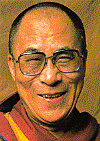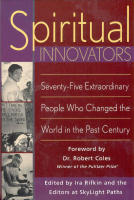|
Each of the ClickToSee websites below opens in a new window.
When done, close new window to return to this page. |
 |
The Dalai Lama laughing. (This will play only if your computer is set up
for sound.) |
 |
 This site is recommended by the book and includes historical and current
affairs. It is a mixture of politics and religion, of culture and modern
issues, of injury and help. This site is recommended by the book and includes historical and current
affairs. It is a mixture of politics and religion, of culture and modern
issues, of injury and help. |
 |
From the above site, this link connects to the pages for The Delai Lama.
They include his history, accomplishments (including Nobel Prize), and
quite a few of his speeches. |
 |
The link to the Delai Lama page on the  site. site. |
|
|
|
|
|
| More Quotations |
|
"Living in society, we should share the sufferings of our fellow citizens
and practise compassion and tolerance not only towards our loved ones but
also towards our enemies. This is the test of our moral strength."
... A Human Approach to World Peace
|
| ·" I believe all religions pursue the same goals, that of cultivating
human goodness and bringing happiness to all human beings. Though the means
might appear different the ends are the same." ... Nobel Prize acceptance
speech. |
| "I always believe that it is much better to have a variety of religions,
a variety of philosophies, rather than one single religion or philosophy.
This is necessary because of the different mental dispositions of each
human being. Each religion has certain unique ideas or techniques, and
learning about them can only enrich one's own faith." ... at the interfaith
service held by the World Congress of Faiths |
| " I, for one, strongly believe that individuals can make a difference
in society. Every individual has a responsibility to help move our global
family in the right direction and we must each assume that responsibility.
As a Buddhist monk, I try to develop compassion within myself, not simply
as a religious practice, but on a human level as well. To encourage myself
in this altruistic attitude, I sometimes find it helpful to imagine myself
standing as a single individual on one side, facing a huge gathering of
all other human beings on the other side. Then I ask myself, 'Whose interests
are more important?' To me it is quite clear that however important I may
feel I am, I am just one individual while others are infinite in number
and importance." ...The United Nations World Conference on Human Rights,
Vienna, Austria, 15 June, 1993 |
|
| Class Notes by: Melinda Bennett |
Who is the Dalai Lama?
· The spiritual leader and head of Tibet
· Thought to be the re-incarnation of the 13th Dalai Lama and therefore
the incarnation of the Buddha of Compassion
Who is the 14th Dalai Lama and how was he chosen?
· Lhamo Dhondrub was found at the age of two in a small village called
Takster in northeastern Tibet after a vision by the Regent of Tibet.
· Lhamo correctly identified items previously belonging to the 13th Dalai
Lama
· Lhamo correctly identified, by name, the leader and servant of the search
party that was sent to find him.
· Enthroned Feb. 22, 1940 at the age of 4.
· Was renamed Jetsun Jamphel Ngawang Lobsang Yeshe Tenzin Gyatso meaning
Holy Lord, Gentle Glory, Compassionate, Defender of the Faith, Ocean of
Wisdom.
· Generally referred to by Tibetans as Yeshe Norbu (the Wishfulfilling
Gem) or Kundun (The Presence).
· Obtained his Doctorate of Buddhist Philosophy at age 25 in 1959.
What made His Holiness flee Tibet?
· In 1950, Tenzin Gyatso was called upon to assume full political power
as 80 000 Chinese Peoples Liberation Army soldiers invaded Tibet.
· In 1959, the Tibetan Nationalists staged an uprising to remove the Chinese
from Tibet. They were crushed by the Chinese and the Dalai Lama escaped
to Dharamsala, India.
· Currently 120 000 Tibetans live in exile in Dharamsala
How has the Dalai Lama maintained the culture and religion of his people?
· A Tibetan educational system was established to raise refugee children
with full knowledge of their language, history, religion and culture.
· The Tibetan Institute of Performing Arts was established in 1959
· A university, The Central Institute of Higher Tibetan Studies, was established
in India.
· Over 200 monasteries were constructed to preserve the Tibetan Buddhist
teachings.
· Helped establish a democratic constitution for his people, based on Buddhist
principles and the Universal Declaration of Human Rights.
· In 1987, at the Congressional Human Rights Caucus in Washington, D.C.,
he proposed a Five-Point Peace Plan between Tibet and China.
· Travelled to 46 nations proposing non-violent solutions to international
conflicts, solutions to environmental problems and human rights issues.
He has made the struggle of his people known throughout the world.
How has the world recognized his efforts?
· Received the Raoul Wallenberg Congressional Human Rights Award in 1989
"His Holiness the Dalai Lama's courageous struggle has distinguished
him as a leading proponent of human rights and world peace. His ongoing
efforts to end the suffering of the Tibetan people through peaceful negotiations
and reconciliation have required enormous courage and sacrifice."
- Congressman Tom Lantos during the Award ceremony
· Nobel Peace Prize 1989
"The Committee wants to emphasize the fact that the Dalai Lama in
his
struggle for the liberation of Tibet consistently has opposed the use of
violence.
He has instead advocated peaceful solutions based upon tolerance and mutual
respect in order to preserve the historical and cultural heritage of his
people."
Quotes by the Dalai Lama: (added above)
From where are some of the Dalai Lama's inspirations?
· Mahatma Gandhi
· Writings from the 8th century Buddhist saint Shantideva:
For as long
as space endures
And for as
long as living beings remain,
Until then
may I too abide
To dispel the
misery of the world. |
|
 |



